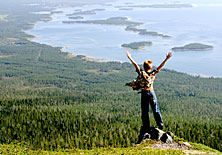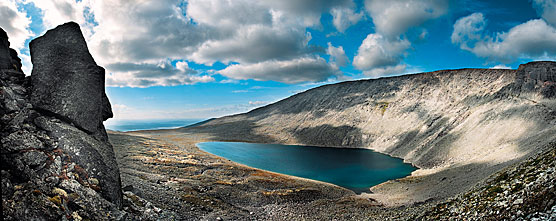Press release 2013-09-11 at 11:46

© Photo: Sergey Osipov
The majority of the boreal forest zone's primeval forest and natural mires are located in Russia. As a result of extensive cooperation between Finland and Russia, the most valuable nature areas in northwest Russia have now been mapped. Northwest Russia has many important protected areas, and more are being planned. A recent English publication provides information on and tools for promoting nature conservation, sustainable forestry and land-use planning.
The Gap project (analysis of gaps and representativeness of the protected area network in northwest Russia) identified the largest high conservation value areas in the Republic of Karelia, the Murmansk, Arkhangelsk, Vologda and Leningrad Regions, and the City of St. Petersburg. The Gap project was born of the need of forestry and conservation actors to map the most valuable, large nature areas in northwest Russia, in order to prevent the loss of their unique natural value.
Support for planning nature conservation and land use planning
The publication Atlas of high conservation value areas, and analysis of gaps and representativeness of the protected area network in northwest Russia maps the high conservation value forests and mires in northwest Russia. The book consists of a description of the natural areas and a map section. An Internet atlas provides a detailed look at the vast forest wilderness in northwest Russia.
The survey work for the publication involved the interpretation of satellite images, which was backed up by available map material and habitat and species data. “Information on the relationships between forest structure and species composition, obtained from several Nordic studies, was used as background information. Forests in northwest Russia are home to a number of forest species that have become threatened elsewhere, including Finland,” explains Tapio Lindholm, Leading Expert at the Finnish Environment Institute.
Positive conservation decisions have been made in northwest Russia, such as the establishment of a national park in the Onega Peninsula in early 2013. “Scheduled for this year are the establishment of the Ingermanlandsky Strict Nature Reserve and a national park on Ladoga skerries. There are also plans for a national park in Khibiny, expansion of Paanajärvi National Park, and many regional protected areas in the near future,” says Anna Kuhmonen, Project Leader at the Finnish Environment Institute.
Many of the valuable natural areas identified by the Gap analysis are included in regional conservation plans, but their natural value will be safeguarded only after official conservation decisions have been made. Depending on the area, the final conservation decision is made either by officials of the Russian Federation or by regional authorities.

|
|
Khibiny. Photo: Valentin Zhiganov
|
Report was produced as a result of Finnish-Russian collaboration
The Finnish Environment Institute was responsible for translating and editing the English Edition of the publication on the gaps and representativeness of the protected area network, which was originally published in Russian in 2011. Russian experts from research institutes, universities, regional environmental administration and nature conservation organisations from northwest Russia and Moscow were responsible for the research and survey work for the publication. In Finland, the work was coordinated by the Finnish Environment Institute and supported by expert and research institutes, universities and environmental non-governmental organisations. The Gap project was funded by Finland's Ministry of the Environment and Ministry for Foreign Affairs, from the Finland's neighbouring area co-operation funding.
The report's findings can be used for nature conservation and sustainable land use planning not only in Russia but also in Finland and other Nordic countries. The information provided by the atlas is useful for assessing the overall status of nature conservation in boreal forests. In the Barents Region – in the northern parts of Finland, northwest Russia, Sweden and Norway – assessment of the protected area network is performed under the Barents Protected Area Network (BPAN) project, coordinated by the Finnish Environment Institute.
Further information
Leading Expert Tapio Lindholm, Finnish Environment Institute, tel. +358 40 7401 598, firstname.lastname@environment.fi
Project Leader Anna Kuhmonen, Finnish Environment Institute, tel. +358 400 473 470, firstname.lastname@environment.fi
Researcher Jevgeni Jakovlev, Finnish Environment Institute, tel. +358 40 180 1692, firstname.lastname@environment.fi
Photos for media
Atlas of high conservation value areas, and analysis of gaps and representativeness of the protected area network in northwest Russia publication's cover.
A lady's-slipper-orchid (Cypripedium calceolus) in the planned nature monument Erin Mountain. Murmansk Region. Photo: Gennady Aleksandrov
Photo: Valentin Zhiganov
Intact herb-rich spruce-mire in boreal forest of Maksimjärvi area. Planned zakaznik Spokoyny, Republic of Karelia. Photo: Jyri Mikkola
There are still intact forest landscapes fragmented by lakes in northwest Russia stretching in every direction to the horison. Photo: Sergey Osipov
The planned zakaznik Poryi Forest. Murmansk Region. Photo: Gennady Aleksandrov.